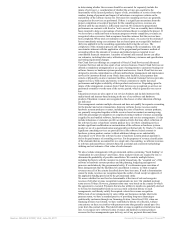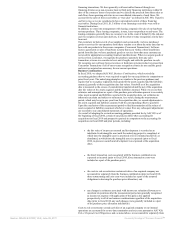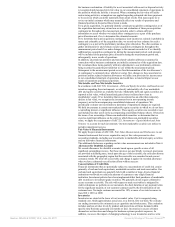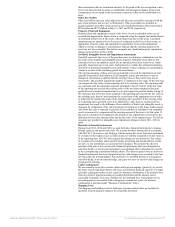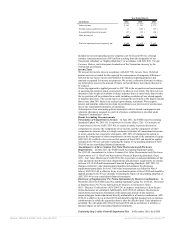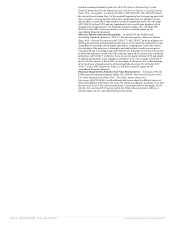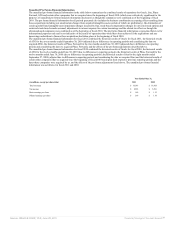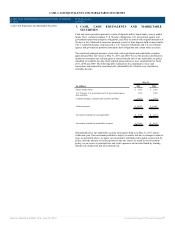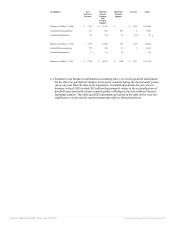Oracle 2010 Annual Report Download - page 173
Download and view the complete annual report
Please find page 173 of the 2010 Oracle annual report below. You can navigate through the pages in the report by either clicking on the pages listed below, or by using the keyword search tool below to find specific information within the annual report.
Year Ended May 31,
(in millions) 2011 2010 2009
Interest income $ 163 $ 122 $ 279
Foreign currency gains (losses), net 11 (148 ) (55 )
Noncontrolling interests in income (97 ) (95 ) (84 )
Other income, net 109 56 3
Total non-operating income (expense), net $ 186 $ (65 ) $ 143
Included in our non-operating income (expense), net for fiscal 2010 was a foreign
currency remeasurement loss of $81 million resulting from the designation of our
Venezuelan subsidiary as “highly inflationary” in accordance with ASC 830, Foreign
Currency Matters, and subsequent devaluation of the Venezuelan currency by the
Venezuelan government.
Income Taxes
We account for income taxes in accordance with ASC 740, Income Taxes. Deferred
income taxes are recorded for the expected tax consequences of temporary differences
between the tax bases of assets and liabilities for financial reporting purposes and
amounts recognized for income tax purposes. We record a valuation allowance to reduce
our deferred tax assets to the amount of future tax benefit that is more likely than not to
be realized.
A two-step approach is applied pursuant to ASC 740 in the recognition and measurement
of uncertain tax positions taken or expected to be taken in a tax return. The first step is to
determine if the weight of available evidence indicates that it is more likely than not that
the tax position will be sustained in an audit, including resolution of any related appeals
or litigation processes. The second step is to measure the tax benefit as the largest amount
that is more than 50% likely to be realized upon ultimate settlement. We recognize
interest and penalties related to uncertain tax positions in our provision for income taxes
line of our consolidated statements of operations.
A description of our accounting policies associated with tax related contingencies and
valuation allowances assumed as a part of a business combination is provided under
“Business Combinations” above.
Recent Accounting Pronouncements
Presentation of Comprehensive Income: In June 2011, the FASB issued Accounting
Standards Update No. 2011-05, Comprehensive Income (Topic 220)—Presentation of
Comprehensive Income (ASU 2011-05), to require an entity to present the total of
comprehensive income, the components of net income, and the components of other
comprehensive income either in a single continuous statement of comprehensive income
or in two separate but consecutive statements. ASU 2011-05 eliminates the option to
present the components of other comprehensive income as part of the statement of equity.
ASU 2011-05 is effective for us in our first quarter of fiscal 2013 and should be applied
retrospectively. We are currently evaluating the impact of our pending adoption of ASU
2011-05 on our consolidated financial statements.
Amendments to Achieve Common Fair Value Measurement and Disclosure
Requirements: In May 2011, the FASB issued Accounting Standards Update
No. 2011-04, Amendments to Achieve Common Fair Value Measurement and Disclosure
Requirements in U.S. GAAP and International Financial Reporting Standards (Topic
820)—Fair Value Measurement (ASU 2011-04), to provide a consistent definition of fair
value and ensure that the fair value measurement and disclosure requirements are similar
between U.S. GAAP and International Financial Reporting Standards. ASU 2011-04
changes certain fair value measurement principles and enhances the disclosure
requirements particularly for level 3 fair value measurements (as defined in Note 4
below). ASU 2011-04 is effective for us in our fourth quarter of fiscal 2012 and should be
applied prospectively. We are currently evaluating the impact of our pending adoption of
ASU 2011-04 on our consolidated financial statements.
Disclosure of Supplementary Pro Forma Information for Business Combinations: In
December 2010, the FASB issued Accounting Standards Update No. 2010-29, Disclosure
of Supplementary Pro Forma Information for Business Combinations (Topic
805)—Business Combinations (ASU 2010-29), to improve consistency in how the pro
forma disclosures are calculated. Additionally, ASU 2010-29 enhances the disclosure
requirements and requires description of the nature and amount of any material,
nonrecurring pro forma adjustments directly attributable to a business combination. ASU
2010-29 is effective for us in fiscal 2012 and should be applied prospectively to business
combinations for which the acquisition date is after the effective date. Early adoption is
permitted. We will adopt ASU 2010-29 in fiscal 2012 and do not believe it will have a
material impact on our consolidated financial statements.
Performing Step 2 of the Goodwill Impairment Test: In December 2010, the FASB
Source: ORACLE CORP, 10-K, June 28, 2011 Powered by Morningstar® Document Research℠







